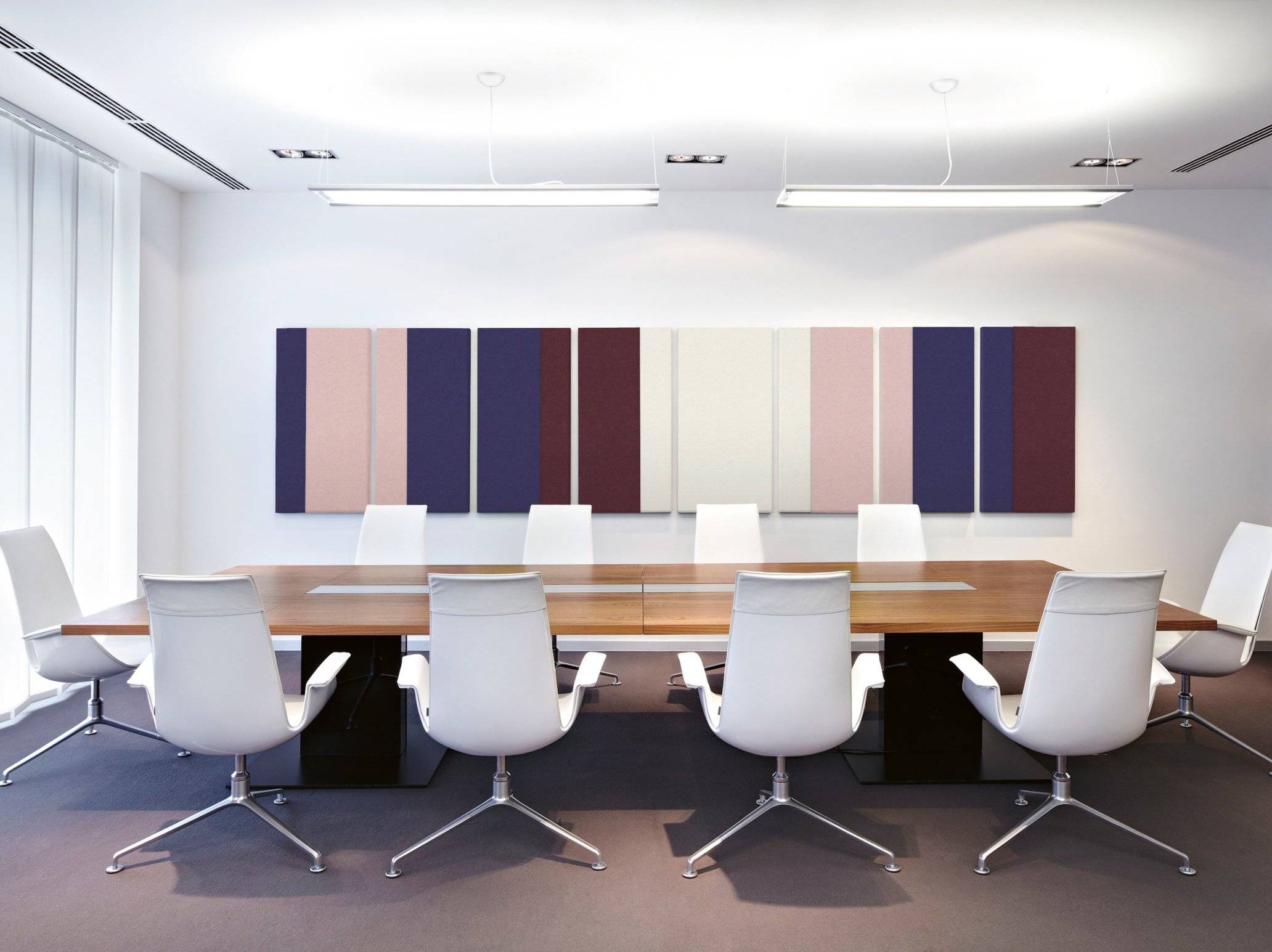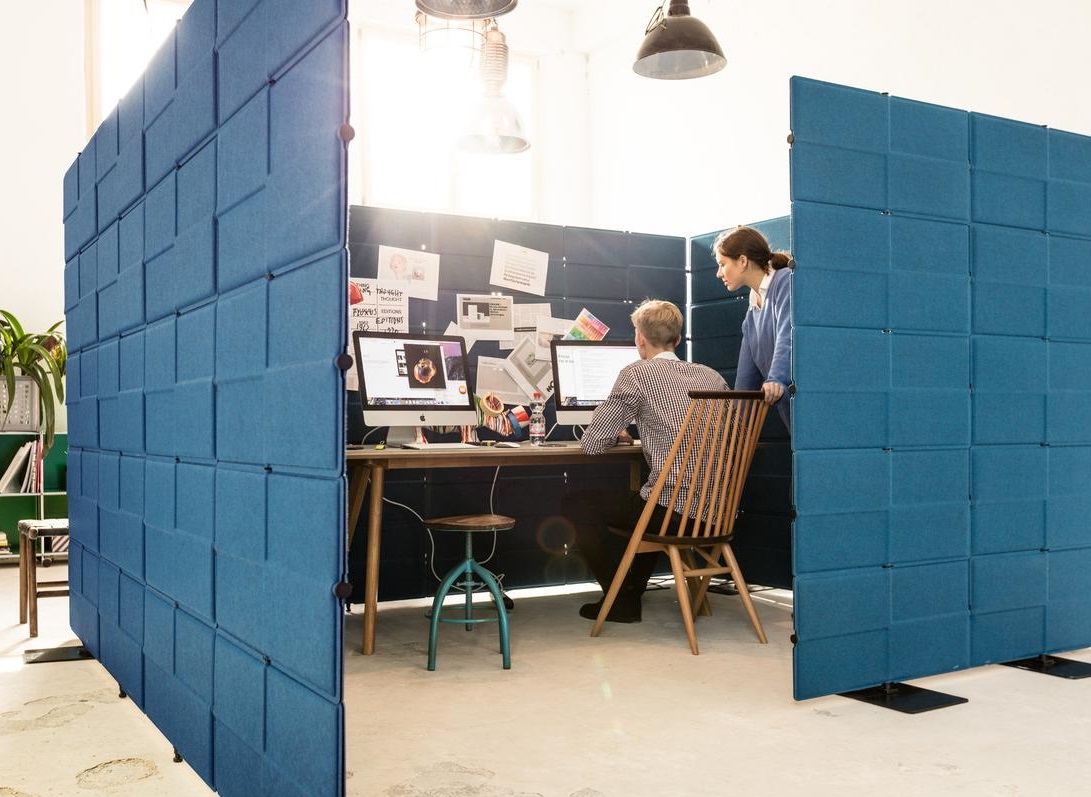OPTIMUM ACOUSTICS IN THE OFFICE
Improve Room Acoustics in the Workplace
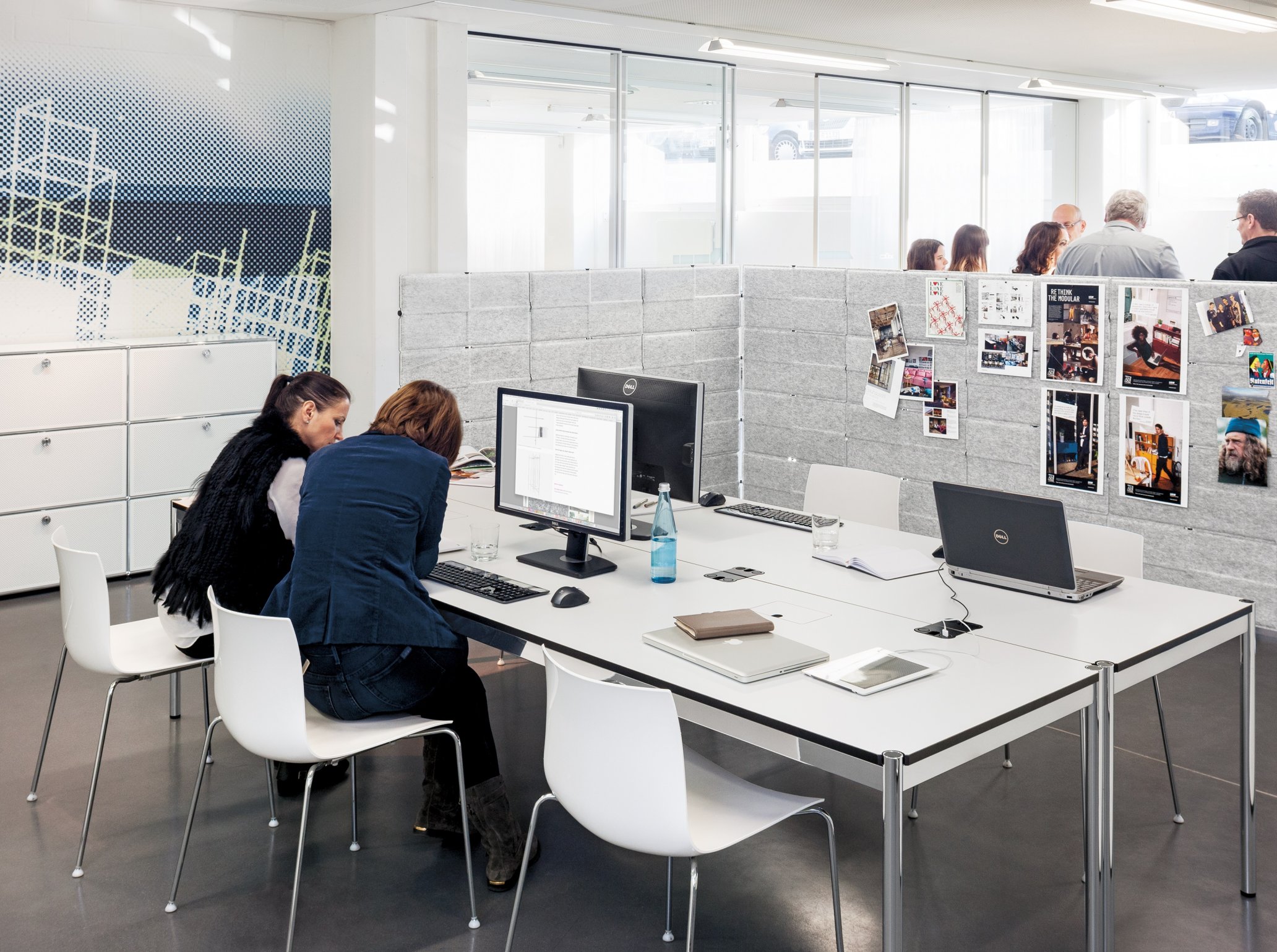
SOUND - NOISE - ACOUSTIC
Generally considered, sound is that which can be audibly perceived. More precisely, it is the propagation of pressure and density oscillations in an elastic medium. For room acoustics the propagation of vibrations in air is relevant and is referred to as airborne sound.
Sounds that are damaging to health, disturbing or stressful on account of their volume and structure are called noise. Noise is subjective: whether a sound is perceived as such depends on the listener's physical and mental constitution, mood, habits, and preferences. At bedtime or when undertaking activities which require extra concentration, sounds are more likely to be perceived as noise. Also, beloved sounds tend not to be perceived as noise even at high volume, while unloved sounds are distracting even at low volume.
This phenomenon is referred to as psychoacoustics. In psychoacoustics one differentiates between useful sound, for example music at a concert or familiar voices during a conversation, and background noise, i.e. distracting background noises such as construction site or traffic noise, but also annoying music or loud conversations of which one is not party. Depending on the recipient, speech and music can therefore express themselves as either useful or as disturbing noise – a phenomenon which is particularly relevant in offices, for all open-plan offices.
Architectural acoustics and room acoustics are often incorrectly used interchangeably; however, the central question of architectural acoustics is how much noise travels from one side of a space to the other, or how sound transfers from one space to another and as such is about sound insulation through doors, walls, ceilings or windows. Room acoustics, on the other hand, is about surfaces which can help create optimal listening and speaking conditions in a room. Important in this context are the sound insulation and sound absorption properties of the materials in room, that is, their ability to dampen sound or convert the incident sound energy into another form of energy.
Through optimising room acoustics, the perception quality within a room should be optimised for its users: be it in a concert hall, a classroom, a broadcasting studio, a meeting room or an open-plan office. In which context it is important that the room acoustics take into account the characteristics of the human ear, the characteristics of our speech reception as well as the subjective hearing habits of the individual.
Sounds that are damaging to health, disturbing or stressful on account of their volume and structure are called noise. Noise is subjective: whether a sound is perceived as such depends on the listener's physical and mental constitution, mood, habits, and preferences. At bedtime or when undertaking activities which require extra concentration, sounds are more likely to be perceived as noise. Also, beloved sounds tend not to be perceived as noise even at high volume, while unloved sounds are distracting even at low volume.
This phenomenon is referred to as psychoacoustics. In psychoacoustics one differentiates between useful sound, for example music at a concert or familiar voices during a conversation, and background noise, i.e. distracting background noises such as construction site or traffic noise, but also annoying music or loud conversations of which one is not party. Depending on the recipient, speech and music can therefore express themselves as either useful or as disturbing noise – a phenomenon which is particularly relevant in offices, for all open-plan offices.
Architectural acoustics and room acoustics are often incorrectly used interchangeably; however, the central question of architectural acoustics is how much noise travels from one side of a space to the other, or how sound transfers from one space to another and as such is about sound insulation through doors, walls, ceilings or windows. Room acoustics, on the other hand, is about surfaces which can help create optimal listening and speaking conditions in a room. Important in this context are the sound insulation and sound absorption properties of the materials in room, that is, their ability to dampen sound or convert the incident sound energy into another form of energy.
Through optimising room acoustics, the perception quality within a room should be optimised for its users: be it in a concert hall, a classroom, a broadcasting studio, a meeting room or an open-plan office. In which context it is important that the room acoustics take into account the characteristics of the human ear, the characteristics of our speech reception as well as the subjective hearing habits of the individual.
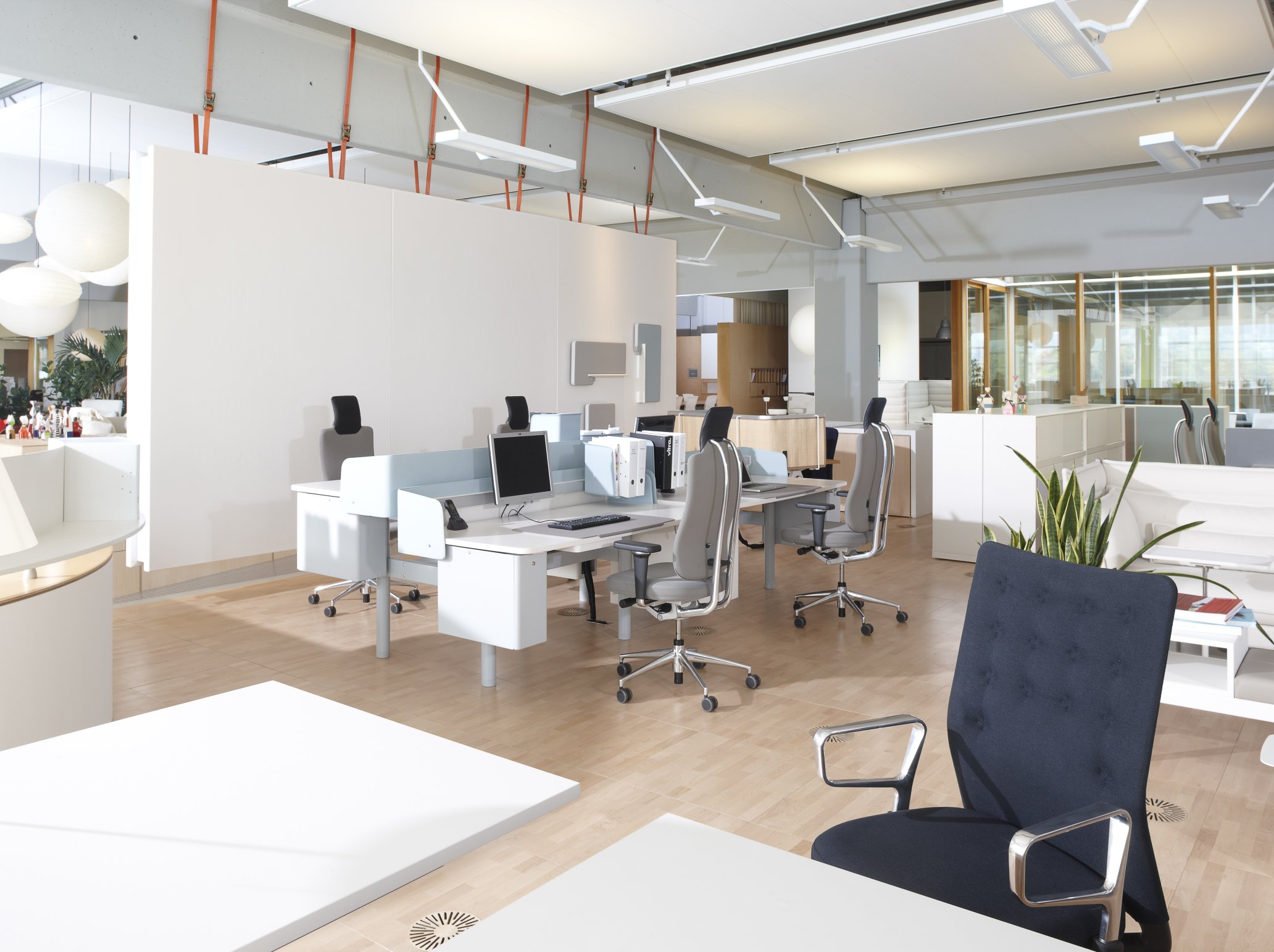
PARAMETERS OF ROOM ACOUSTICS
In addition to psychoacoustic criteria, the perception of sound as noise also depends on physically measurable parameters such as the sound pressure level. The sound pressure level, L, is usually expressed in decibels, dB. The dB scale starts at 0 dB, where human auditory perception starts, and ends at about 140 dB, roughly the volume of an aircraft taking off. However, continuous noise levels as low as 80 dB can cause lasting damage to our hearing, and even below these levels a permanently high background sound level can be very unhealthy.
Another important characteristic in room acoustics is the reverberation time, i.e. the time span in which the sound pressure level of a sound event in a room has decreased by 60 dB. In simple terms, it indicates the length of time a sound event requires after its completion in order to be inaudible in a room. The reverberation time is an important comparative feature and can be used when evaluating spaces in terms of their room acoustic quality.
The speech intelligibility in a room depends on the position of the listener in relation to the source and thus cannot be specifically measured for a given room. In general, however, it can be said that the Speech Transmission Index (STI), which describes speech intelligibility, decreases the more the transmission is disturbed by the influences of the room, such as through additional sound sources, echoes or reverberation.
Another important characteristic in room acoustics is the reverberation time, i.e. the time span in which the sound pressure level of a sound event in a room has decreased by 60 dB. In simple terms, it indicates the length of time a sound event requires after its completion in order to be inaudible in a room. The reverberation time is an important comparative feature and can be used when evaluating spaces in terms of their room acoustic quality.
The speech intelligibility in a room depends on the position of the listener in relation to the source and thus cannot be specifically measured for a given room. In general, however, it can be said that the Speech Transmission Index (STI), which describes speech intelligibility, decreases the more the transmission is disturbed by the influences of the room, such as through additional sound sources, echoes or reverberation.

Another important concept is audibility, i.e. the acoustic quality of a room in terms of its speech intelligibility – that is, the suitability of a room for very specific sound performances, especially linguistic communication and musical performance. The audibility of a room is influenced by the characteristics of the room boundary surfaces and furnishings, or by persons present: adequate audibility exists when we feel comfortable in a room, are able to communicate effectively, and do not perceive it as too loud or quiet.
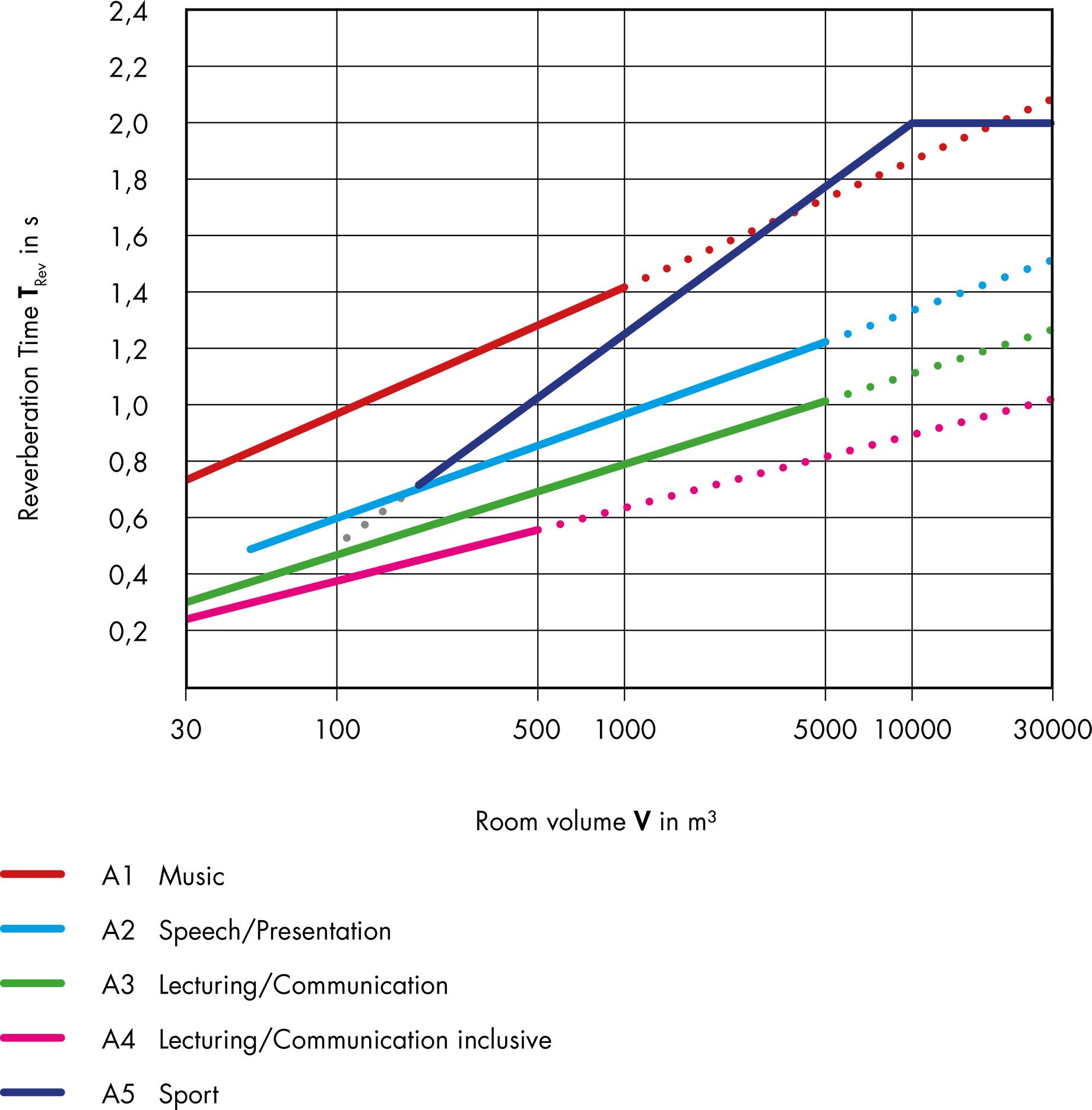
Sound frequency is defined by the number of sound pressure changes per second and is quoted in Hertz (Hz). In this case, the human ear perceives sound events with a high frequency as high pitched, low-frequency sound events as low tones. Depending on age the normal human hearing range is between 20 and 20,000 Hz, with adult human speech covering a range of around 200 to 1,000 Hz. In this range our hearing is particularly sensitive: which on the one hand facilitates interpersonal communication, but on the other it also makes us particularly vulnerable to disruptions through other people's conversations, which can be a real problem in terms of concentration in the workplace.
Sound propagation is also important. Sound propagates in a space in all directions, with the speed of sound propagation dependent on the medium. In air the propagation of a sound wave occurs at a speed of about 343 m/s; consequently in small rooms sound is very quickly disseminated. In addition to the room size, space delimitation areas and furniture influence acoustics. The larger the room, the more important the positioning of sound absorbers and sound screens, and here the requirements of the room must always be planned accordingly: for example, while sound propagation in a lecture room should be managed with the aim of promoting speech intelligibility, in multi-person offices sound propagation should be restricted through the use of shielding and absorption devices.
Sound propagation is also important. Sound propagates in a space in all directions, with the speed of sound propagation dependent on the medium. In air the propagation of a sound wave occurs at a speed of about 343 m/s; consequently in small rooms sound is very quickly disseminated. In addition to the room size, space delimitation areas and furniture influence acoustics. The larger the room, the more important the positioning of sound absorbers and sound screens, and here the requirements of the room must always be planned accordingly: for example, while sound propagation in a lecture room should be managed with the aim of promoting speech intelligibility, in multi-person offices sound propagation should be restricted through the use of shielding and absorption devices.
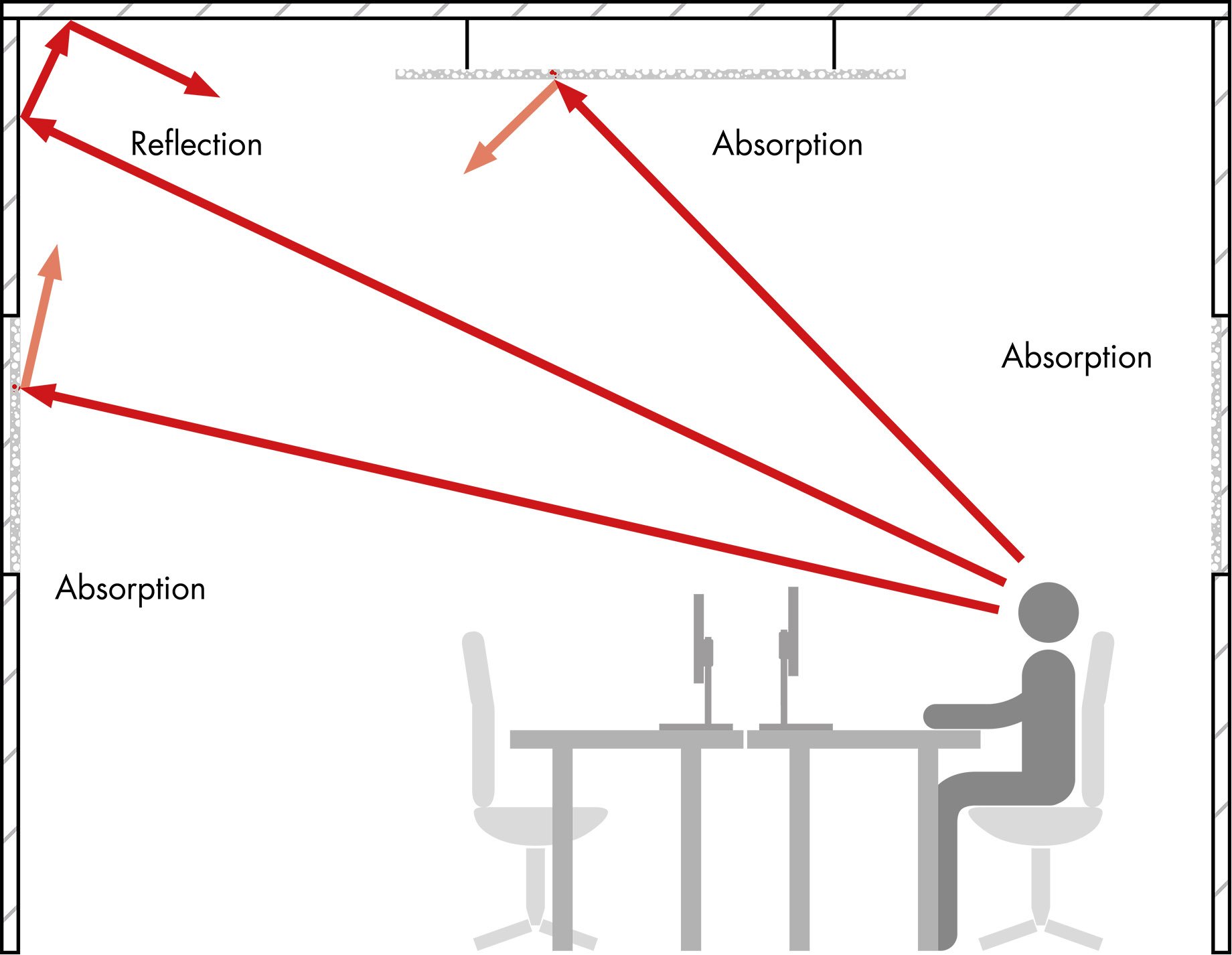
A screen is an obstacle which reduces or stops the direct propagation of sound from a source to a receiver. This can be, for example, a desk attachment, a partition wall or a cupboard. The closer a sound screen is to the sound source and the longer the thus generated detour, the more effectively the sound propagation is reduced. If sound screens are equipped with an absorbent surface, the sound propagation is further reduced both in the entire room and locally in front of and behind the screen. The number and arrangement of sound-absorbing surfaces is also relevant for an acoustic environment.
SOUND ABSORPTION
From the perspective of room acoustics, the ability to absorb sound is a crucial property of surfaces and materials. The effect of such absorbers is frequency-dependent: high frequencies can usually be damped by low hung sound absorbers, while for damping low frequencies absorbers need to be placed higher and/or cover a larger area. The sound absorption of areal arrangements such as ceilings, walls or floor coverings as well as sound screens is represented by the sound absorption coefficient which describes the property of a material to convert and absorb impacting sound - its absorption effect relative to one square meter of material. An ideal sound absorber, one which completely absorbs the incident sound, has a sound absorption coefficient of 1, whereas a completely reflecting surface has a sound absorption coefficient of 0.
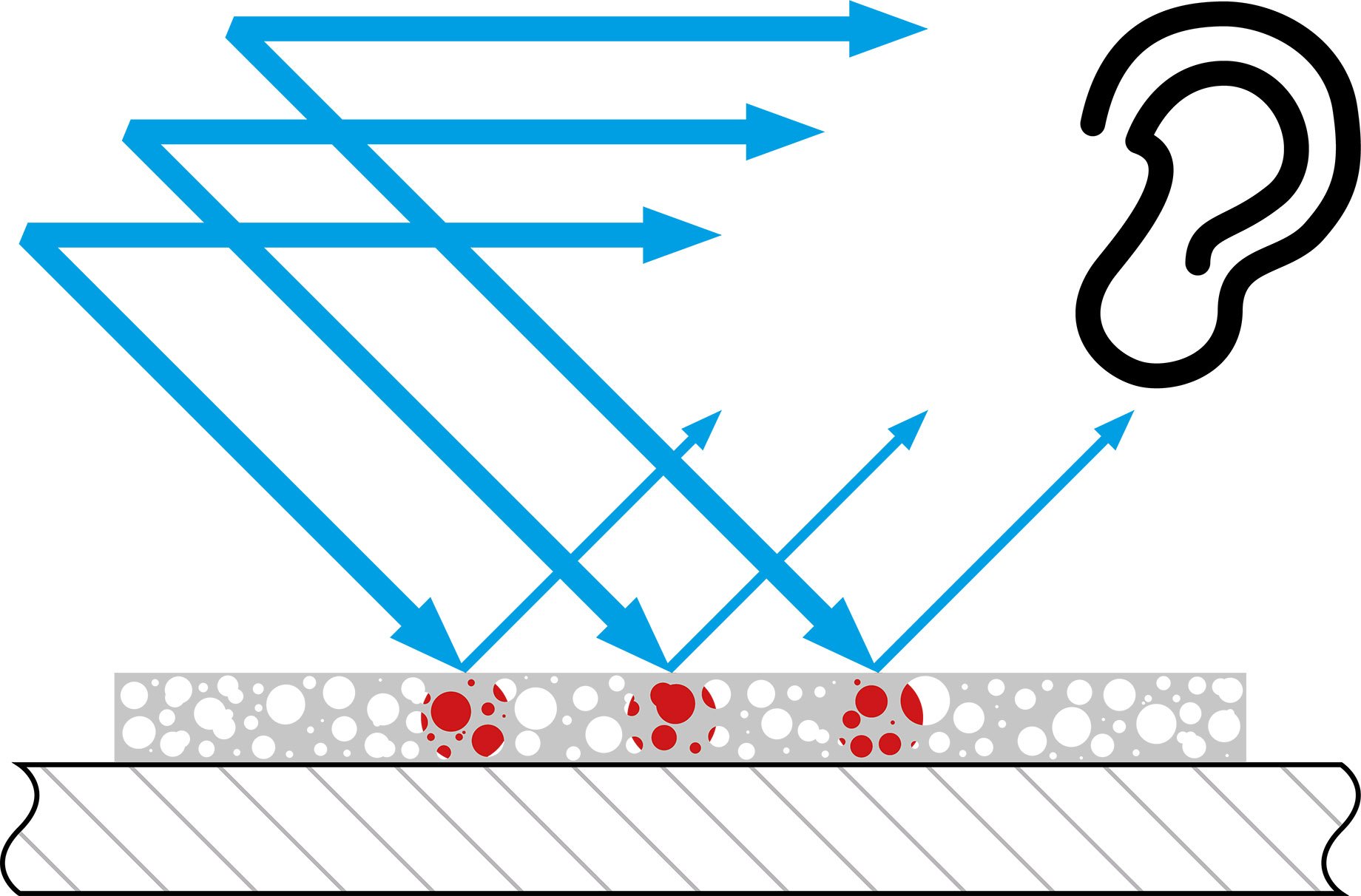
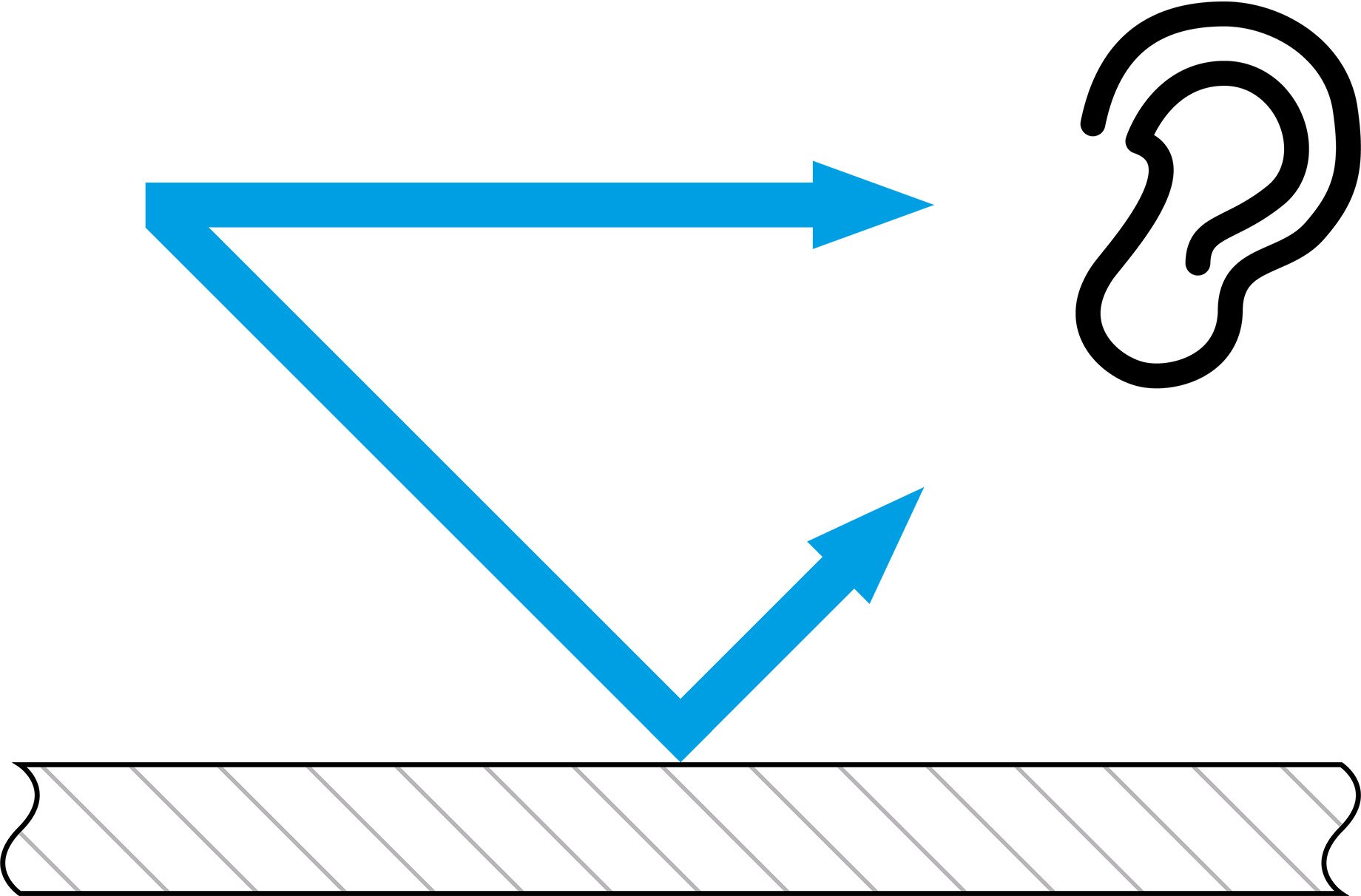
The size of the absorber surface in the room is essential. If one considers a completely furnished space with its different surfaces, then each material can be assigned a sound absorption factor, S, and, which through multiplication with the absorber surface of the room, α, gives its equivalent absorption area, Aobj. This is calculated for elements such as tables, chairs and cabinets and is also frequency dependent; thus, a small area with a high degree of absorption is just as effective as a large area with a low degree of absorption. The rule is: If there are several cabinets in a room, their effect multiplies. That is, two cabinets promote twice as much absorption as a single cabinet.
Adding the equivalent absorption areas for all materials and objects in a room gives its total equivalent sound absorption area (Aeq), which in turn determines the reverberation time using Sabine's formula: physicist Wallace Clement Sabine defined that reverberation time T is proportional to room volume V and to the equivalent absorption area A: T = 0.163 x V / A
Adding the equivalent absorption areas for all materials and objects in a room gives its total equivalent sound absorption area (Aeq), which in turn determines the reverberation time using Sabine's formula: physicist Wallace Clement Sabine defined that reverberation time T is proportional to room volume V and to the equivalent absorption area A: T = 0.163 x V / A
A distinction is made between two classes of absorbers: absorbers which use any type of resonance mechanism, such as trapped air volume or a vibrating surface, are referred to as resonance absorbers. These are primarily suitable for the absorption of sound from medium to low frequencies. Secondly one has porous absorbers including, for example, mineral fibers, foams, carpets or fabrics. Their effect is based on the fact that the sound can penetrate into the open structures of the material, where the sound energy at the surface of the pores is then converted by the friction of the air particles into heat energy. Porous absorbers are primarily effective at medium to high frequencies.
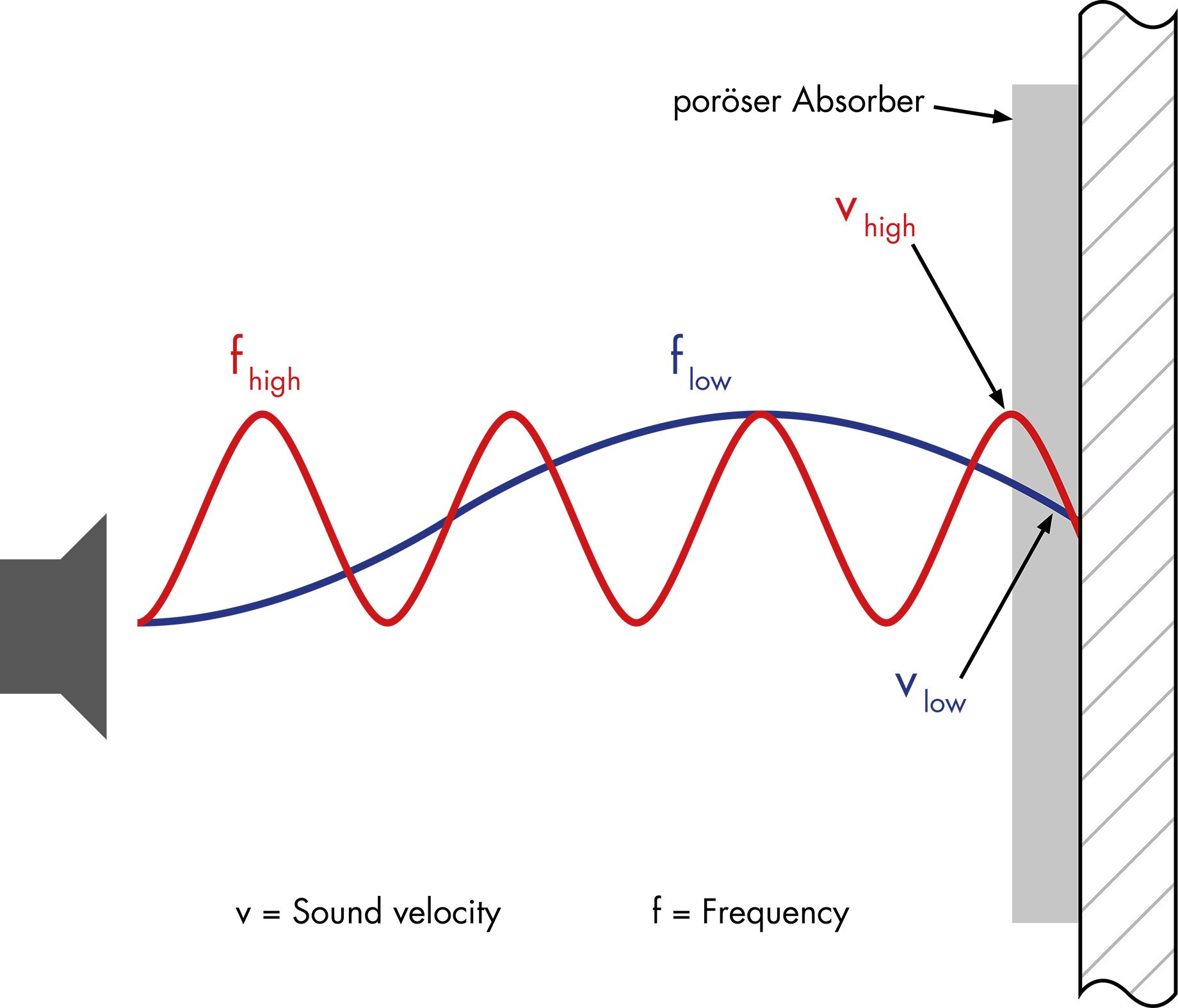
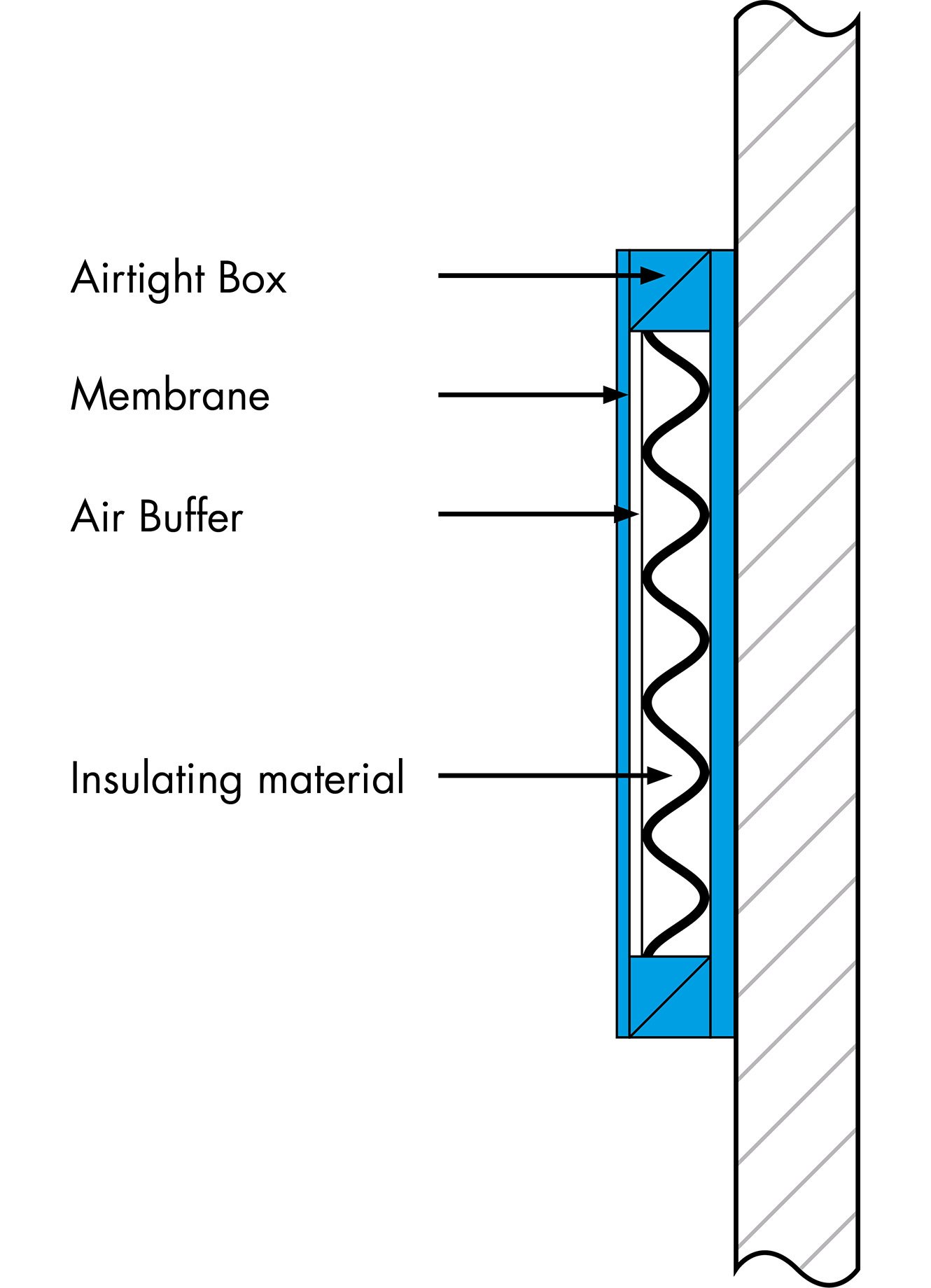
OPTIMAL ACOUSTICS IN OPEN-PLAN OFFICES
The complex topic of acoustics is extremely important in the workplace, yet is far too often neglected - even though around 70 percent of all employees work in offices. In office and work environments unwanted noise is often perceived as a disruptive factor which severely affects both performance and the local feel-good factor - especially in open-plan offices. Studies show that acoustics is one of the most important factors for our well-being: any investment in good room acoustics is therefore an investment in satisfaction, health, concentration and thus efficiency of employees. A forward-looking planned or subsequently optimised room acoustic is therefore worthwhile and pays off through lasting effects. Thanks to their modularity, acoustic systems such as those made by USM Haller or Acousticpearls allow tailor-made solutions for improved room acoustics, resulting in higher employee satisfaction and increased productivity through sound absorption and sound shielding - without the need for structural changes. Existing spaces can be easily retrofitted.
With the help of acoustic calculations and precise measurements it is possible to determine exactly where, which, acoustic elements should be placed in order to achieve acoustic optimisation, meaning that each space can receives its own customised solution.
With the help of acoustic calculations and precise measurements it is possible to determine exactly where, which, acoustic elements should be placed in order to achieve acoustic optimisation, meaning that each space can receives its own customised solution.


